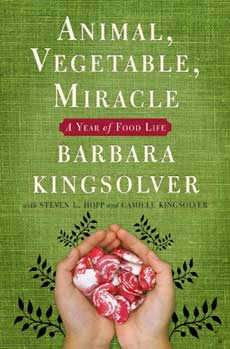 by Barbara Kingsolver, with Steven L. Hopp and Camille Kingsolver A Review by George R. Pasley October 09, 2007
The alternative lifestyle they adopted is that of locovore- a person who eats only locally produced foods. That does not mean they raised all their own foods, though they raised much of their annual food supply. It does not mean they ate only foods native to their region. Instead, it means that (with an occasional minor diversion) they ate food that was produced within a short drive of their home in southwest Virginia. The bulk of the book is written by popular author Barbara Kingsolver (The Poisonwood Bible, etc., etc.). Interesting scientific asides are written by her college professor husband Steve Hopp, and a college student point of view is added by Barbara's oldest daughter, Camille, who also adds some fascinating recipes. Barbara's family has taken some hits from the official farming community, mostly the American farm Bureau, whose writers have sharply criticized her because she offers a critique of modern industrialized agriculture (commercial confined animal production, acute specialization, long distance transport, etc.). I think this criticism is undeserved, as Kingsolver's point is not to criticize farmers, but criticize a system that puts more and more farmers out of business every year. Her economic argument Is that consumption of local food benefits local farm economies and keeps more small farmers in business. Included in the book is a short summary of a local group of farmers and the difficulty they have had attempting to market locally grown crops. Also included in the book are descriptions of successful local marketing attempts in other parts of the United States, and of a local food culture in Italy. But such descriptions of what is in the book lead away form its central nature, which is that of narrative, which even includes a plot of sorts: How will they make it? How will the year end? And, how will the human race adapt and survive? Quite artfully, Kingsolver ends the book with a suspenseful story about turkey eggs, using the story as a metaphor for the human race. Building on Wendell Berry, Kingsolver argues simply that modern Americans are too ignorant about our food and therefore too sloppy in our choices about food and use of the land. The narrative nicely serves as a food-comes from-soil, animals-live-and-die-and-we-eat-them story for the previously uniformed. The chapters flow nicely, following
the calendar from April to April, 13 months on the farm. But
each chapter can readily stand alone, and be read almost as a
short story. For those interested in the specifics of supporting
community agriculture, small farms, or the myriad other subjects
brought up in the book, there is a handy list of reference materials
and sources of further information. My only wish is for an index.
On the Web:
Publish A Letter in SitNews Read Letters/Opinions
|
||
